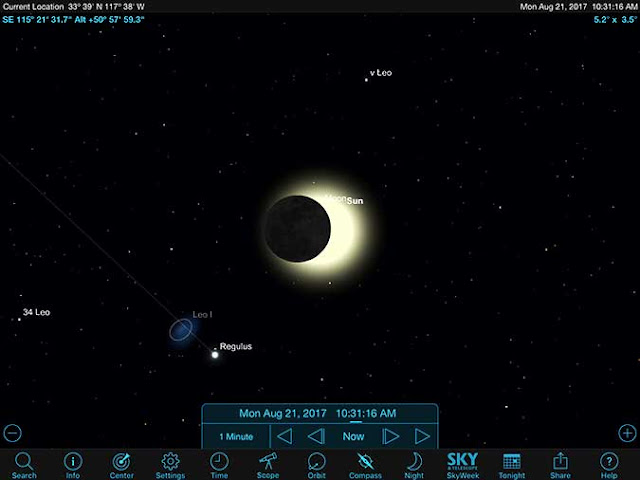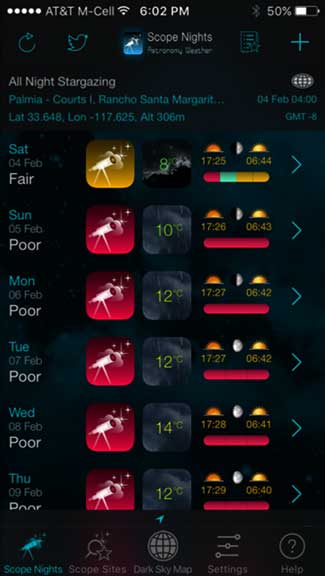Well last week was filled with indoor study and this week I hoped to collect some preliminary data for the upcoming total solar eclipse on August 21, 2017. The observing plan for this week is to get images of the background stars that will be visible during the total eclipse. This data gathering was the same type of thing that Eddington had to do when he planned to photograph the 1919 solar eclipse as a test verification of Einstein general theory of relativity. You need to know the position of the background stars without the sun present and then take an image during the solar eclipse and see how much those star positions have shifted due to the gravitation of the sun which bends the star light. When will those background stars be visible during the night you ask? Well if we know the sky location of where the total solar eclipse will occur, which will of course be in the daytime, we can see those same stars in the nighttime six months prior to the eclipse. So the observing plan for
this week is to take an image of those background stars now. Where are you going to be on that date and which background stars will be visible then? We will be in Casper Wyoming for an astronomy conference and of course experiencing the total solar eclipse. Now I know that many of you are planning to be in other locations on that date and even for all of you that remain here in southern California, you will still be able to observe a partial solar eclipse.
Check out this Sky Safari Pro screenshot which shows the location of the sun and moon as it should be observed, not on the line of total solar eclipse, but from the observatory location here in southern California. Note that the moon does not totally block the light from the sun, but it should still be a pretty neat event right here. If you are at the total solar eclipse path that crosses the whole United States and passes directly through Casper, Wyoming, the moon will completely block out the sun and only the dimmer solar corona will be visible from those locations.
 |
| Sky Safari Pro screenshot shows background stars near August 21, 2017 solar eclipse |
Oh, oh, the weather has not been cooperating very much to accommodate amateur astronomers. It has mostly been accommodating us physicist wannabes by keeping us inside at night studying. So, one of the topics I was reviewing was how much the light from a star would be bent by the gravity of the sun. Well, if you check out the gravity book I recommended in the last post, "A Most Incomprehensible Thing" by peter Collier, you can find how to calculate the amount of deflection. In chapter 9, he summarizes he long mathematical formulation of the problem with the summary formula for calculating the deflection as equal to 4*G*M/(b*c^2), where G is Newton's gravitational constant, M is the mass of the sun, c is the speed of light and b is the impact parameter, which is just a fancy name for how close the light beam comes to the sun. In our case, we assume the light beam just grazes the surface of the sun, so b will be he radius of the sun. Now if you carry out the calculation and convert the deflection to arc seconds we find the deflection to be just 1.75 arc seconds. So if it happens that the test star is two solar radii away from the center of the sun, the deflection would be just 1/2 of the 1.75 arc seconds, still pretty darn small.
Wow, that is a very small deflection and I am certainly not going to observe it with my planned use of just my 300mm telephoto lens. Yes, I could take my bigger scope with 950 mm focal length and use a Barlow lens and try to get better angular resolution, but it seems just way to much to take all of that equipment to Wyoming. Beside, we want to just experience the eclipse too and not be fiddling with the equipment and camera all the time. But other amateurs do indeed try to repeat this famous experimental verification. If you are interested you can check out a neat article from Sky and Telescope magazine that includes a presentation first made in 2016 at the Society of Astronomical Science meeting held in Ontario, CA. This article includes a lot of details about picking exposure times, etc, for best imaging and identified Eddington's telescope focal length as 2100mm. If you are interested you can read that article by Donald Bruns at: http://www.skyandtelescope.com/wp-content/uploads/Bruns-SAS2016-paper-v7.pdf
Now I have attended that conference, made up of many very, very serious amateur astronomers and then even some more beginning astronomers like me. Several OCA members attend that conference each year including former OCA Secretary, and Author, Bob Buchheim, who is the SAS president. In previous posts, I have mentioned how much I enjoy Bob's books and am so grateful for his advice and feedback over the years. If you want to check out the details of this years conference, to be held June 15-17, 2017, check out SAS webpage at: http://www.socastrosci.org/
The forecast for this week has been for clouds and rain, but look at the one glimmer of hope in the Scope Nights screenshot below. Wow, a whole lot of red indicates poor observing conditions. See how for Saturday night, only, there is just one little point of time where the clouds will be gone, indicated by the green in the timeline, for a couple of hours just before midnight Saturday.
 |
| Scope Nights App Screenshot shows just one small opportunity for this week |
So, I grabbed my tripod, already with the mounted camera and 300mm lens, and set up outside in about 5 minutes. My GoSkyWatch IPhone app helped orient where I should look for Regulus and luckily this time there were no clouds at that location. Actually, the setup time took a little longer because I had to go back inside to get my astronomers chair because Regulus was so high in the sky that I couldn't bend low enough to sight it in. With the chair in place, I used the red dot finder to point at the brightest star I could see in the location where Regulus was supposed to be and took some images. Regulus could be seen in the camera Livescreen and I took several images with exposures ranging from four seconds to 1/8 second.
Ok, I thought I had found the correct location for Regulus, but to be sure, I uploaded the image to Astrometry.net to get confirmation that Regulus was indeed in the camera frame. See the confirmation page below.
 |
| Astrometry.net confirms Resident Astronomer eyeball location of Regulus is right on |
 |
| Palmia Observatory image showing next solar eclipse background stars in Constellation Leo 300mm focal length and two second exposure with brightest star, Regulus, magnitude 1.4 |
So that is about it for this post. Resident Astronomer Peggy and I just returned from the market with a bottle of champagne to toast the winning Super Bowl LI team. We don't really care who wins as long as we get to toast the winner. That sounds like a winning approach no matter what!
Until next time,
Resident Astronomer George
There are over 200 postings of similar topics on this blog
If you are interested in things astronomical or in astrophysics and cosmology
Check out this blog at www.palmiaobservatory.com

No comments:
Post a Comment